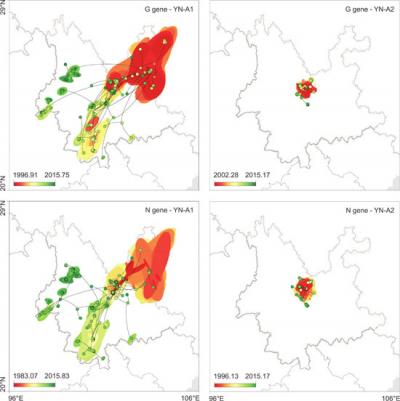
Credit: Tian H, et al. (2018)
Domestic dogs play a key role in the transmission and expansion of rabies in rural areas of China, according to a study published December 6 in the open-access journal PLOS Pathogens by Huaiyu Tian of Beijing Normal University, Hailin Zhang of the Yunnan Provincial Key Laboratory for Zoonosis Control and Prevention, Simon Dellicour of KU Leuven, and colleagues.
Despite ongoing efforts to control transmission, rabies prevention remains a challenge in many developing countries, especially in rural areas of China where re-emerging rabies is under-reported due to a lack of sustained animal surveillance. Although dogs are known to be the primary reservoir and vector of human rabies in African and Asian countries, the epidemiology of rabies virus spread in developing regions is still unclear. These uncertainties hamper improvements in disease control strategies and the evaluation of control measures. Taking advantage of detailed genomic and epidemiological data for the re-emerging rabies outbreak in Yunnan, a rural province of China, collected between 1999 and 2015, the authors reconstructed the demographic and dispersal history of the rabies virus in domestic dogs and estimated the transmission rate between dogs and from dogs to humans.
Epidemiological analyses revealed that transmission rates between dogs, as well as between dogs and humans, are lower than estimates for Africa. The reconstructed epidemic history of the rabies virus among dogs and the dynamics of rabid dogs were consistent with recorded human rabies cases. The results indicate that interventions in the dog population would be effective in reducing transmission to humans, in particular because they have the potential to subvert the self-sustaining capacity of epidemics in dogs. “We reconstruct the recent dispersal history of RABV in domestic dogs in Yunnan, a rural province of China, and estimate RABV transmission rate between dogs and from dogs to humans,” notes Tian. According to the authors, a better understanding of rabies virus spread is necessary to help inform the prevention and control of human rabies in the vast rural areas of China.
###
Research Article
Funding: Funding for this study was provided by the National Natural Science Foundation of China (81673234, 41476161), http://www.
Competing Interests: The authors have declared that no competing interests exist.
Citation: Tian H, Feng Y, Vrancken B, Cazelles B, Tan H, Gill MS, et al. (2018) Transmission dynamics of re-emerging rabies in domestic dogs of rural China. PLoS Pathog 14(12): e1007392. https:/
Image Credit: Tian H, et al. (2018)
Image Caption: Fig 3. Spatiotemporal diffusion of Yunnan RABV clades estimated from continuous phylogeographic reconstructions.
Author Affiliations:
State Key Laboratory of Remote Sensing Science, College of Global Change and Earth System Science, Beijing Normal University, Beijing, China
Yunnan Institute of Endemic Diseases Control and Prevention, Yunnan Provincial Key Laboratory for Zoonosis Control and Prevention, Dali, China
KU Leuven, Department of Microbiology and Immunology, Rega Institute, Laboratory of Evolutionary and Computational Virology, Leuven, Belgium
Institut de Biologie de l’École Normale Supérieure UMR 8197, Eco-Evolutionary Mathematics, École Normale Supérieure, France
Unité Mixte Internationnale 209, Mathematical and Computational Modeling of Complex Systems, Institut de Recherche pour le Développement et Université Pierre et Marie Curie, Bondy, France
School of Biomedical Informatics, the University of Texas Health Science Center at Houston, Houston, Texas, United States of America
Department of Zoology, University of Oxford, Oxford, United Kingdom
Centre for Ecological and Evolutionary Synthesis (CEES), Department of Biosciences, University of Oslo, Blindern, Oslo, Norway
Ministry of Education Key Laboratory for Earth System Modeling, Department of Earth System Science, Tsinghua University, Beijing, China
In your coverage please use this URL to provide access to the freely available paper: http://journals.
Media Contact
Huaiyu Tian
[email protected]
Related Journal Article
http://dx.
News source: https://scienmag.com/




